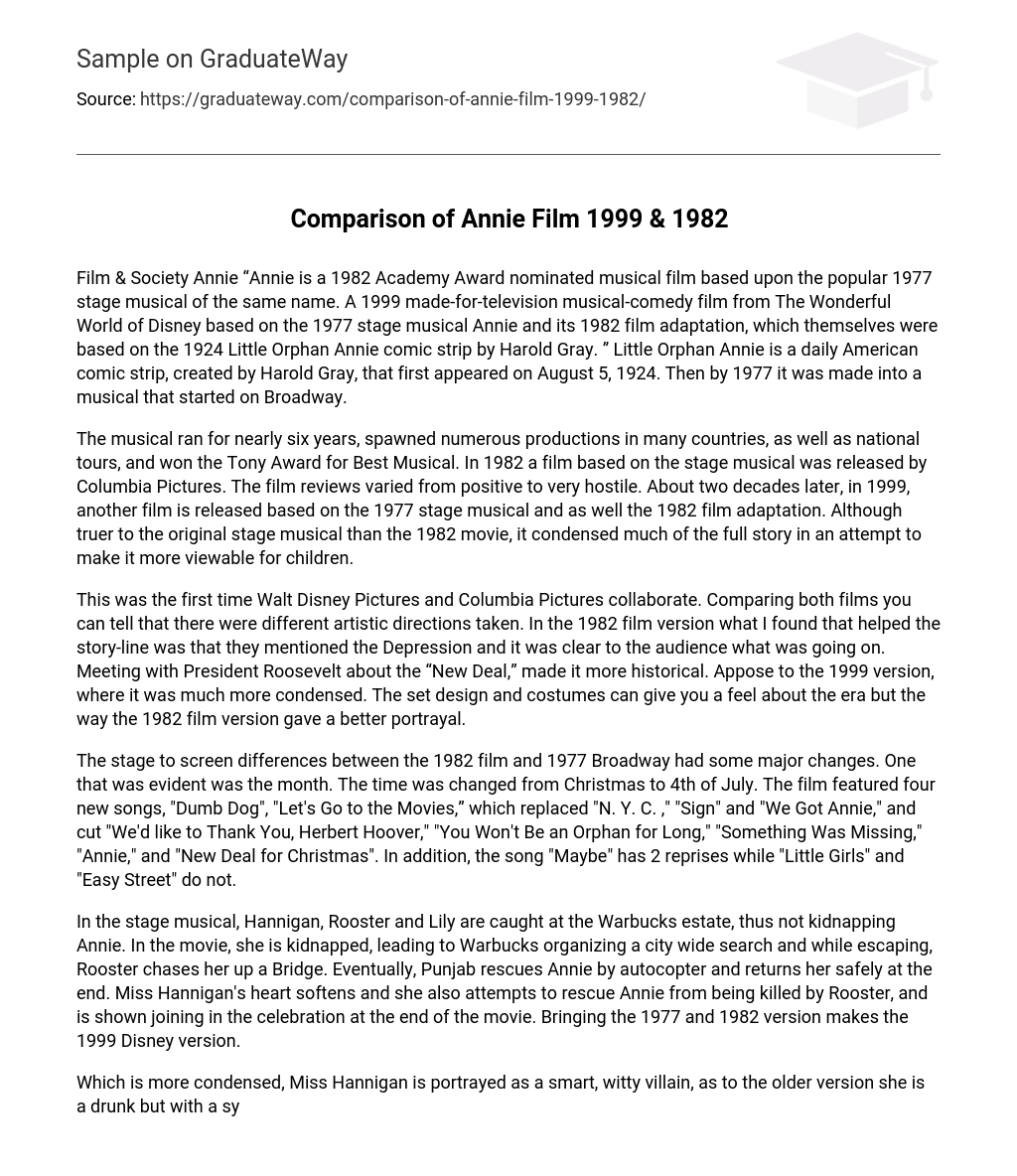Film & Society Annie “Annie is a 1982 Academy Award nominated musical film based upon the popular 1977 stage musical of the same name. A 1999 made-for-television musical-comedy film from The Wonderful World of Disney based on the 1977 stage musical Annie and its 1982 film adaptation, which themselves were based on the 1924 Little Orphan Annie comic strip by Harold Gray. ” Little Orphan Annie is a daily American comic strip, created by Harold Gray, that first appeared on August 5, 1924. Then by 1977 it was made into a musical that started on Broadway.
The musical ran for nearly six years, spawned numerous productions in many countries, as well as national tours, and won the Tony Award for Best Musical. In 1982 a film based on the stage musical was released by Columbia Pictures. The film reviews varied from positive to very hostile. About two decades later, in 1999, another film is released based on the 1977 stage musical and as well the 1982 film adaptation. Although truer to the original stage musical than the 1982 movie, it condensed much of the full story in an attempt to make it more viewable for children.
This was the first time Walt Disney Pictures and Columbia Pictures collaborate. Comparing both films you can tell that there were different artistic directions taken. In the 1982 film version what I found that helped the story-line was that they mentioned the Depression and it was clear to the audience what was going on. Meeting with President Roosevelt about the “New Deal,” made it more historical. Appose to the 1999 version, where it was much more condensed. The set design and costumes can give you a feel about the era but the way the 1982 film version gave a better portrayal.
The stage to screen differences between the 1982 film and 1977 Broadway had some major changes. One that was evident was the month. The time was changed from Christmas to 4th of July. The film featured four new songs, “Dumb Dog”, “Let’s Go to the Movies,” which replaced “N. Y. C. ,” “Sign” and “We Got Annie,” and cut “We’d like to Thank You, Herbert Hoover,” “You Won’t Be an Orphan for Long,” “Something Was Missing,” “Annie,” and “New Deal for Christmas”. In addition, the song “Maybe” has 2 reprises while “Little Girls” and “Easy Street” do not.
In the stage musical, Hannigan, Rooster and Lily are caught at the Warbucks estate, thus not kidnapping Annie. In the movie, she is kidnapped, leading to Warbucks organizing a city wide search and while escaping, Rooster chases her up a Bridge. Eventually, Punjab rescues Annie by autocopter and returns her safely at the end. Miss Hannigan’s heart softens and she also attempts to rescue Annie from being killed by Rooster, and is shown joining in the celebration at the end of the movie. Bringing the 1977 and 1982 version makes the 1999 Disney version.
Which is more condensed, Miss Hannigan is portrayed as a smart, witty villain, as to the older version she is a drunk but with a sympathetic heart. Also Miss Hannigan is taken to a mental institution at the end of the television movie. Which never occurred in the stage play or 1982 film. The character of Punjab does not appear, and for the first time an African-American women plays Grace Farrell. My first taste of Annie was the 1999 version, which I thought was great but it being Disney it took out a lot of what should have been shown. However, I like this version because it shows more of how the original stage play is.
I’ve recently watched the 1982 version and found it to be more “real” then just a sad story about an orphan. The cast was used very well, from getting to know the orphans to the servants. Although it didn’t necessarily follow the original stage play. All three versions of Annie have been made differently but all convey the message of hardship in that time and how hard it was to get a job and have a child. By adding a bit of variety it keeps the more the interesting how directors approach a musical like this. Especially with Disney, that have to





